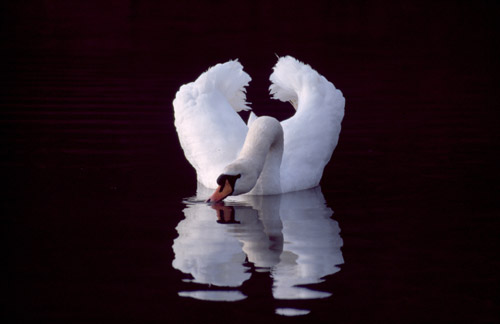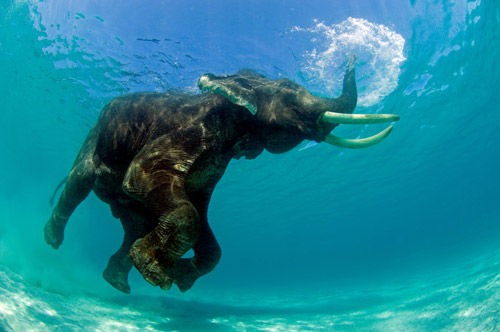
| HOME |
| NERVE |
| REVIEWS |
| ARCHIVE |
| EVENTS |
| LINKS |
| ABOUT US |
| CONTRIBUTORS |
| BACK ISSUES |
| CONTACT US |
 |
| Becky L. Chadd - Mute swan / Wild Planet |
Wild Planet
An exhibition of 80 classic wildlife shots chosen by BBC personality
and zoologist Chris Packham from previous years of Wildlife Photographer
of the Year
World Museum,
William Brown Street, Liverpool
18th July - 28th October 2012
Reviewed by Sandra Gibson
I recently reviewed the Liverpool Art Prize. Robyn Woolston’s winning installation last was a rallying cry to a world that is strangling itself with the wasteful by-products of greed and stupidity. This week a man in a polar bear suit* was arrested at a Shell petrol station - Greenpeace protesters have been using the emergency shut-off switches to stop fuel getting to the pumps in order to draw attention to the company’s plans to drill for oil in Alaska. Activists have expressed fears for the “fragile and beautiful Arctic” and its creatures. Sir David Attenborough has gone so far as to express doubts about the survival of the human race. Wild Planet, an exhibition of the non-human inhabitants of our Earth, gives us additional reasons to take heed. In one dramatic photograph, Termite catching by Kristin J. Mosher, a chimpanzee raises its arms in a gesture of what looks like desperation. This is a creature facing extinction, like many of the animals portrayed; their habitats have been curtailed or destroyed by the human exploitation of resources and by global warming. Polar bears scavenging by Howie Garber is an image for our times. A group of polar bears has been drawn to scavenge the corpse of a grey whale. This is unusual because polar bears are solitary animals who hunt on sea-ice but climate change has caused the sea-ice to retreat, stranding them on land.
We’re next for the chop if we don’t wise up but the exhibition is not solely concerned with extinction. It is essentially celebratory: a celebration of beauty and diversity and survival by a group of people with the mind and heart and technical skills to do it well.
I thought the juxtaposition of contrasting photographs was particularly skilful. For example, Clash of the bulls by Martyn Colbeck is an action-blurred shot in browns and sepias. Next is a photograph characterised by the silhouetted stillness of the subjects, the action coming from the powerful conflagratory colours created by early morning sun burning mist. Arthur Morris’s Snow geese in morning light creates momentary confusion because what looks like an environment on fire is not creating the expected behaviour in the geese. The trio is completed by Big fish little fish by Len Deeley: an elegant and humorous ‘still life’ in cool blues and silvers – the perfect foil to the other two pictures. What I particularly appreciated was the way the accompanying information continued with the narrative, so we get the outcome of the clash of the bulls!
Some photographs celebrate the beautiful markings animals have; Crab and sea cucumber by Brandon D Cole is a good example. Next to a close-up showing the texture of feathers and the piercing duck egg blue eye of Helmut Moik’s Dalmatian pelican is a creature from outer space. The young horned katydid, caught on camera by Brian Kenney is a cartoon creature in green and yellow, its eyes popping. It makes you laugh out loud. Crown jellyfish by Pete Atkinson and Lava by moonlight by Olivier Grunewald are also in the other-worldly category. They have a surrealistic beauty and Grunewald’s black, white and red study reminds us of the power of the geological processes that form the earth and contribute to its fecundity.
You also come to realise the time and energy cost to the photographer in getting their pictures. Young photographer Evan Graff had to crawl on his stomach to get his extraordinary photograph Skimmers on show where the birds with comedy legs and beaks become larger further away, seeming to defy the conventional rules of perception. Benjamin D. Walls waited hours for the sun’s reflected light to appear at exactly the right part of the pool he photographed in Elements. This thermal pool in Yellowstone Park vibrates with colour intensity: the unreal blue of the water is edged with contrasting yellow and orange bacteria and algae - the warm and the cool colours intensifying one another - and the composition is relieved by the long-awaited patch of white sunlight. A reminder of dependence.
For decorative power look at Ben Osborne’s Elephant creation where the animal almost dissolves in movement and light. In terms of sheer poetic beauty it would be hard to better Becky L. Chadd’s Mute swan (top) for its almost abstract symmetry or Jan Vermeer’s Japanese crane dance which, with its minimal elegance, captures the essence of Japanese art, or Raoul Slater’s Black-headed gulls on weir with its blue and yellow liquidity of lines punctuated by three gulls.
 |
| Rajan snorkelling by Jeff Yonover / Wild Planet |
The previous three works affect the aesthetic sense; there are others whose poignancy pierces the heart. Rajan snorkelling by Jeff Yonover (right) is an underwater shot showing an elephant swimming, using its trunk as a snorkel. What touches you is this intelligent resourcefulness and the fact that the water momentarily lightens the load of his bulk: a burden which elephants in the wild must haul across wild terrain, in search of food and water, in danger of being poached for their ivory.
The Wild Planet exhibition belongs to the Natural History Museum, London and the BBC Wildlife Magazine. Where do you begin when every photograph is the best? This superb exhibition is varied, humorous, elegant, poignant, artistic, poetic, relevant, challenging, informative and spiritual. The photographs, printed on transparency film with a reflective white screen behind are brightly lit from the sides of their frames with LEDs. This is an effective way of displaying the work because you don’t need additional light. As well as the images there is information about the circumstances in which the close encounters took place and about the art of photography, together with some distribution maps, facts and questions.
If there has to be a best photograph then my choice would be American bison de-frosting by Mervin D. Coleman. It shows the iconic majestic silhouette of the animal, his head lowered in patient endurance whilst the sun unfreezes his body. It’s like a moment of rebirth, elevated from the ordinary by the effect of sunlight on the thawing moisture which creates an aura of colour round his body. This remarkable photograph combines stoic survival with dignity and beauty: a mute appeal to our spiritual instincts.
World Museum: www.liverpoolmuseums.org.uk/wildplanet
The winner of the Liverpool Art prize:
www.robynwoolston.com
*Metro 17th July 2012: www.metro.co.uk
Greenpeace: www.greenpeace.org